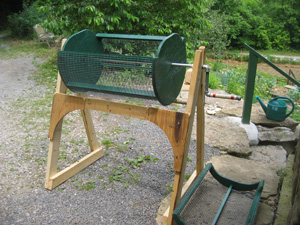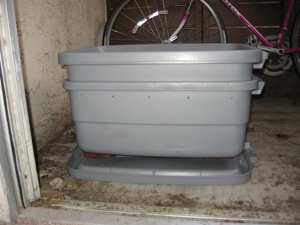In the 2010 book American Wasteland it was reported that Americans waste between a quarter and a half of the 590 billion pounds of food that we produce each year and generate enough food waste every day to fill a 90,000 seat stadium. That is the conservative estimate. At the other extreme we could fill the same stadium twice each day. According to the EPA, 2.8 percent of food waste was composted in 2010. This means that between 143 and 287 billion pounds of food waste ends up in landfills every year. While the front end of this appalling situation presents us with its own set of moral and environmental concerns (future article?), the focus of this article is what to do with the waste we do have.
Even the thriftiest cook would have a hard time making use of apple cores and carrot tops. The solution: composting.
In the Green Living article “The Second Can” (Feb. 2012) we looked at composting as a critical part of reducing our overall garbage footprint. Composting is perhaps one of the lowest hanging fruits out there in the realm of sustainability. Even recycling has its dark side, with the vast array of chemicals and energy inputs necessary to recover the sought after materials. But not composting. The work is done by microorganisms that feed mostly on carbon and nitrogen present in the waste. Although these organisms are pursuing their own metabolic ends, the final product for us is beautiful and rich organic material that is like nectar for tomato plants. Let’s take a look at a few common composting methods that you can easily build at home:
1. Pile composting – this is perhaps the easiest method. I use a three-compartment enclosure to keep things neat, although you could just as easily use a pile. Turning the pile helps ensure that moisture and oxygen are evenly distributed, which is important for the microorganisms. One way to gauge the moisture content is to pack a clump from the pile in your hands. If it falls apart, it is too dry. If liquid runs out, it is too wet.
2. Drum composting – waste is placed in a drum walled with chicken wire that is supported on both ends. Regular rotation of the drum speeds up the process. I took this picture during a short stint at Hidden Springs Farm, just north of Cookeville. An easier way is to use a 55 gallon drum. Food grade drums are available locally from Davey Milby (615) 663-0280 for $15; that’s the best deal you’re gonna find! They also make great rain barrels.
3. Worm composting – the ultimate space saver. Worms make quick work of organic material and are especially fond of coffee grounds and corrugated cardboard (they either like the cornstarch binders or the ability of corrugated cardboard to absorb compost liquids, allowing for a rich microbial environment, the debate rages). Murfreesboro native, Aubrey Scott, recently made a worm composter for his apartment in Davis, Calif. In a phone interview on the topic he commented, “It is amazing how little ends up in the trash once you compost” and “there is really no smell.” The design is simple and compact: two plastic tubs, one with holes drilled in the bottom. The unit could easily fit under a sink. According to Scott, the key is not to feed the worms too much too quickly. He estimates that his initial $15 worm purchase at the garden center (you can likely get them for less at a bait shop) weighed one pound, including the dirt. Worms eat about half of their body weight per day, and he aims for a quadrupling of the initial worm count. The point of feeding slowly is to allow the worm population time to multiply and become established. Another tip is to bury the scraps to deter flies.
If you really want to optimize your compost pile, and who wouldn’t, you can aim for a carbon/nitrogen ratio of 30:1, according to the department of chemistry at Cornell (okay, I’ll admit, I have actually never done this. I usually just throw everything in, and alternate with layers of dead leaves. I think I’ll give it a shot though after doing research for this article). Below is a table from the Cornell website of some commonly composted items, as well as their C/N ratios.
Materials High in Carbon C/N
autumn leaves 30-80:1
straw 40-100:1
wood chips or sawdust 100-500:1
bark 100-130:1
mixed paper 150-200:1
newspaper or corrugated cardboard 560:1
Materials High in Nitrogen C:N
vegetable scraps 15-20:1
coffee grounds 20:1
grass clippings 15-25:1
manure 5-25:1
(Source: Dickson, N., T. Richard, and R. Kozlowski. 1991. Composting to Reduce the Waste Stream: A Guide to Small Scale Food and Yard Waste Composting.)
You can also monitor the internal temperature of your compost. 110-150 degrees F is considered optimal, and direct sunlight helps. The temperature is a good indicator of other process parameters that are more difficult to measure such as the pH, oxygen level, moisture content, particle size and the already mentioned C:N ratio. You can still create good compost outside of the optimal ranges, but it will take longer (Proc. Fla. State Hort. Soc. 107: 387-397, 1994).
Amending a soil with compost is particularly useful in Tennessee clay, as it improves drainage and increases soil aeration. One word of caution though: mixing a compost into the soil before it is ready can actually harm your garden due to toxic substances that are not present in a mature compost. One way to test a batch is to grow a quickly maturing crop such as icicle radish in the mix. If the plants develop yellow leaves, the mix is likely not ready.
And last, but certainly not least, what goes into a compost pile? Here is a table from the University of Wisconsin (a more complete list can be found here).
When composting is combined with the three R’s (Reduce, Reuse, Recycle), there isn’t much left in the weekly pickup. Considering that this is how food scraps have been dealt with for most of human history, it is actually a bit crazy that the technique even requires advocating. It’s a great solution to our food scrap dilemma, after we produce fewer scraps of course, and it provides wonderful soil. And above all, it just plain feels good. What are you waiting for?! Get started, tell your friends and bring a bucket for scraps to the next church picnic or dinner party.















